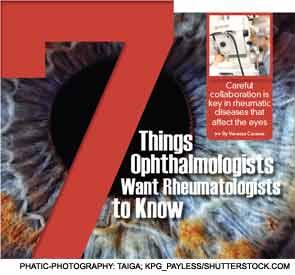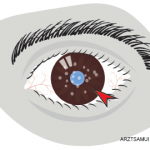
Rheumatologists are no strangers to eye care because a number of rheumatology patients present with or develop eye symptoms.
“Most of the inflammatory diseases we treat as rheumatologists can have ophthalmologic manifestations,” says Christopher M. Wise, MD, professor, internal medicine, rheumatology, allergy and immunology, Virginia Commonwealth University School of Medicine, Richmond, Va.
“In inflammatory arthritis, patients with rheumatoid arthritis may have dry eyes or specific inflammatory processes involving the eye, such as scleritis and uveitis,” says Dr. Wise. “Patients with ankylosing spondylitis, reactive arthritis, and other spondyloarthropathies frequently get uveitis. Plus, a wide range of inflammatory processes involving the eye, ocular muscles or vessels, and orbit can be seen in lupus, primary Sjögren’s syndrome, and most of the vasculitic syndromes—granulomatosis with polyangiitis and temporal arteritis in particular.”
Yet that’s not all. Ocular manifestations can also arise in sarcoidosis, herpes zoster, Behçet’s disease, Crohn’s disease and ulcerative colitis, and juvenile idiopathic arthritis.
7 Tips to Improve Care, Collaboration
It’s not uncommon for patients who do not yet have a diagnosed systemic disease to experience certain ocular problems, leading them to visit their ophthalmologist. The ophthalmologist then makes a referral to a rheumatologist for suspected systemic disease.
“For example, a lot of Sjögren’s patients show up first in the ophthalmologist’s or dentist’s office,” says John D. Sheppard, MD, MMSc, professor of ophthalmology, microbiology & molecular biology, Eastern Virginia Medical School, Norfolk, Va.
Or a rheumatologist may refer a patient because of troublesome eye symptoms or to monitor the patient when he or she uses medications that increase certain ocular risks.
Despite the crossover that often occurs, there are still lessons that rheumatologists can learn from eye specialists to further speed up diagnoses and improve patient care.
Here are seven pearls.
1. Don’t Ignore Ocular Symptoms
“When the eye is involved, it’s very clear that’s a signal of bad things to come. It’s like the canary in the coal mine,” says C. Stephen Foster, MD, founder and president, Massachusetts Eye Research and Surgery Institution, Cambridge, Mass. Dr. Foster is a member of both the American College of Rheumatology as well as the American Academy of Ophthalmology. He has seen, for instance, patients with lupus on a variety of systemic treatments who suddenly experience a change in vision. Although ophthalmologists may recommend more aggressive treatment, some rheumatologists will not heed this advice. Consequently, he has seen patients lose their vision or experience another serious effect, such as kidney impairment.
Bottom line: If there are sudden ocular symptoms, call your ophthalmic colleagues and also investigate for further serious systemic concerns on the horizon.
2. When You Get a Referral from Ophthalmologists, Encourage Them to Be as Specific as Possible
Esen K. Akpek, MD, professor of ophthalmology and rheumatology; director, Ocular Surface Disease and Dry Eye Clinic, and associate director, Johns Hopkins Jerome L. Greene Sjögren’s Syndrome Center, Johns Hopkins University School of Medicine, Baltimore, believes her ophthalmic colleagues need to be more detailed regarding a patient’s signs and symptoms when referring to a rheumatologist. They should also list any possible systemic diagnoses and what drugs could be appropriate.
The lesson for rheumatologists: Ask eye doctors to get specific, because the information they provide is crucial for you to order the appropriate workup. “If you don’t do the proper workup, you can never get the right diagnosis,” Dr. Akpek says.
By getting detailed, the ophthalmologist and rheumatologist can get to the heart of the problem. Dr. Akpek also encourages rheumatologists to pick up the phone at least once to discuss a patient’s collaborative care with an ophthalmologist—something that sounds obvious but does not happen often enough, she adds.
That said, remember that ophthalmologists often stay focused on the eye, meaning their exam results may prevent them from fully considering systemic diagnoses, says George Nick Papaliodis, MD, director, Ocular Immunology and Uveitis Service, Massachusetts Eye and Ear Infirmary, Boston. Dr. Papaliodis is board certified in both internal medicine and ophthalmology. “They may not examine any organ aside from the eye, so the underlying diagnosis may elude them,” he says. That’s why he encourages ophthalmologists to consider nonophthalmic symptom severity and frequency when making a referral to a rheumatologist.
3. Be Careful with Those Steroids
Excessive steroid use can lead to an elevated intraocular pressure (one risk factor for glaucoma) and increase the risk for cataracts. However, it’s common for physicians outside of ophthalmology to prescribe steroids to patients without monitoring their use, says Dr. Akpek. A better idea is to refer to an ophthalmologist if steroid use is involved in the patient’s care to help monitor intraocular pressure and weigh in if steroid use is excessive, Dr. Akpek says (see the sidebar to the right for more referral suggestions).
Two relatively newer corticosteroid implants that ophthalmologists are using for chronic noninfectious uveitis are Retisert (fluocinolone acetonide intravitreal implant) and Ozurdex (dexamethasone intravitreal implant), which can be placed in the eye for two-and-a-half years and six months, respectively, Dr. Papaliodis says. However, even those advances require monitoring for the avoidance of long-term steroid effects.
A newer long-acting intravitreal steroid preparation from pSivida, Iluvein, currently under phase III trials for posterior noninfectious uveitis, can be inserted in the office and may last up to three years, says Dr. Sheppard.
4. Enlist an Ophthalmologist’s Help for the Treatment of Dry Eye Disease
Rheumatologists often recommend the use of artificial tear supplements for patients with dry eye, says Alan Baer, MD, director, Johns Hopkins Jerome L. Greene Sjögren’s Syndrome Center, Johns Hopkins University School of Medicine. However, a variety of other higher-level treatment options is available, including topical cyclosporine drops. Plus, “in some cases, secretagogues like pilocarpine and cevimeline can help promote tear flow and relieve dry eye symptoms,” Dr. Baer says.
Sometimes a patient with an autoimmune disease can have dry eye but not feel the symptoms, which is yet another reason why ophthalmologists should be part of that person’s care, Dr. Akpek says. Without treatment, the patient may experience corneal scarring or a decrease in vision.
Ophthalmologists can also recommend as appropriate the use of punctal plugs, changes to the patient’s environment (e.g., reducing exposure to fans and wind), nighttime ointments and other treatments to help relieve symptoms of dry eye—some of which may sound minor to clinicians but are actually quite irritating to patients.

5.Don’t Back Off of Therapy Too Quickly
Dr. Foster shares the example of a patient with Behçet’s disease on infliximab or azathioprine whose uveitis is in remission. A year goes by, and the rheumatologist decides to cut back on the patient’s treatment. Unfortunately, the uveitis returns. Instead, Dr. Foster advises sticking with aggressive, prolonged, closely supervised therapy to avoid recurrences of serious eye diseases.
6. Hold Simultaneous Clinics with Your Ophthalmic Colleagues When Possible
Dr. Sheppard believes that a special clinic involving both specialties for the treatment of tough patients can save patients time (they come for one appointment vs. two separate ones) and can increase collaboration among physicians. However, he acknowledges that it can be difficult to get patients and the staff members involved from a variety of physicians’ offices in one place at the same time.
If a clinic is not possible, then Dr. Sheppard is also a fan of frequent appropriate referrals, which can offer patients better care and help increase regular collaboration and business between the two specialties. “Teaming with a rheumatologist for these patients is almost always beneficial,” he says.
7. Expect Certain Treatments to Be Part of the Ophthalmologists’ Armamentarium in the Future
Ophthalmology has a “stepchild” image in medicine, so it has to rely on research done in other specialties that can benefit eye care, Dr. Foster says. In that realm, there is research underway with tumor necrosis factor–alpha inhibitors to be used as future treatments for ocular inflammation. Until now, any such use has been off-label, he says.
There are also advances in diagnostic testing that are of interest to rheumatology, Dr. Sheppard says. For example, a new test from the company Nicox should be able to help identify novel Sjögren’s disease auto-antibodies detectable at a much earlier stage than previously possible, he says. Additionally, the National Institutes of Health is conducting a large study to assess the value of salivary biomarkers for the diagnosis of Sjögren’s syndrome.
Vanessa Caceres is a freelance medical writer in Bradenton, Fla.
When to Refer Your Patients to an Ophthalmologist

Ophthalmologists want to see your patients just about any time they have ocular symptoms. Here are a few specific times when a referral to your local trusted eye care specialist is crucial:
- Anytime a patient has redness in the white of the eye, a change in vision, eye pain or light sensitivity. “Those are classic symptoms of inflammation,” Dr. Papaliodis says.
- Symptoms or signs of dry eye that are anything more than mild.
- Photophobia, blurred vision and diplopia (double vision) will prompt Dr. Wise to refer to an ophthalmologist, in addition to redness and pain.
- When a patient is prescribed corticosteroids or hydroxychloroquine. The ophthalmologist can help monitor the patient’s intraocular pressure and cataract risk related to steroid use, as well as retinal toxicity for chloroquine derivatives.
- When a child has juvenile inflammatory arthritis. This referral is key to monitor for the patient’s uveitis risk, Dr. Wise says.
- When a patient has uveitis or scleritis.
- When a patient seeks contact lenses or refractive surgery, because there may be a higher risk of complications in patients with rheumatologic disease, Dr. Sheppard says.


